Eastend Saskatchewan – Three Reasons to Visit
It’s day three of the 2016 RV trip, a ritual that my son Dale and I have been doing for six years. We are leaving our campsite in the Centre Block of Cypress Hills Interprovincial Park heading for the west block of Grasslands National Park. It’s been a wonderful two days which I have described in this post on Cypress Hills and this post on Fort Walsh National Historic Site. The plan for today is to make Eastend Saskatchewan our first stop where we will visit the T.rex Centre and see what else is in town. From there it’ll be on to Shaunavon where I hear there’s a great restaurant and then we have a choice of routes to get us to Val Marie and the entrance to Grasslands N.P. It’s the type of exploring I love – places I’ve never been to and because they are not well known, I really have no idea in my mind’s eye of what to expect. With Willie Nelson’s On the Road Again ringing in my brain we turn the vehicles south on Highway 21 and with apologies to Steppenwolf, head on down the highway, looking for adventure and whatever comes our way. Won’t you join us?
Wallace Stegner House, Eastend Saskatchewan
It’s about a half hour drive to the small town of Eastend Saskatchewan and we arrive before the T.rex Centre is open. It’s about half a mile outside of town so we return to Eastend where I noticed a sign for the Wallace Stegner home. Wallace Stegner was a Pulitzer Prize winning American author whose works I was quite familiar with. Big Rock Candy Mountain is a big, sprawling novel about the consequences of chasing a delusory American dream. Its characters are tragic and pathetic and many consider it the great novel about the American west. So what’s with Stegner and Eastend Saskatchewan? A little research reveals that Stegner’s parents moved here in 1917, built a home and young Wallace lived here for seven years before they returned to Montana.
The house is just off the main street and is now owned by the Eastend Arts Council which operates it as the Wallace Stegner House Residence for Artists. It’s not generally open to the public, but aspiring writers and artists can rent it for a whopping $250.00 a month, utilities included. Talk about a deal for your stereotypical starving artist. Apparently it was the things that young Stegner saw and observed in Eastend Saskatchewan that inspired him to write about life in the west. What a great idea to preserve this house and let others share the same experience. Here’s what the house looks like today, almost 100 years after it was built.
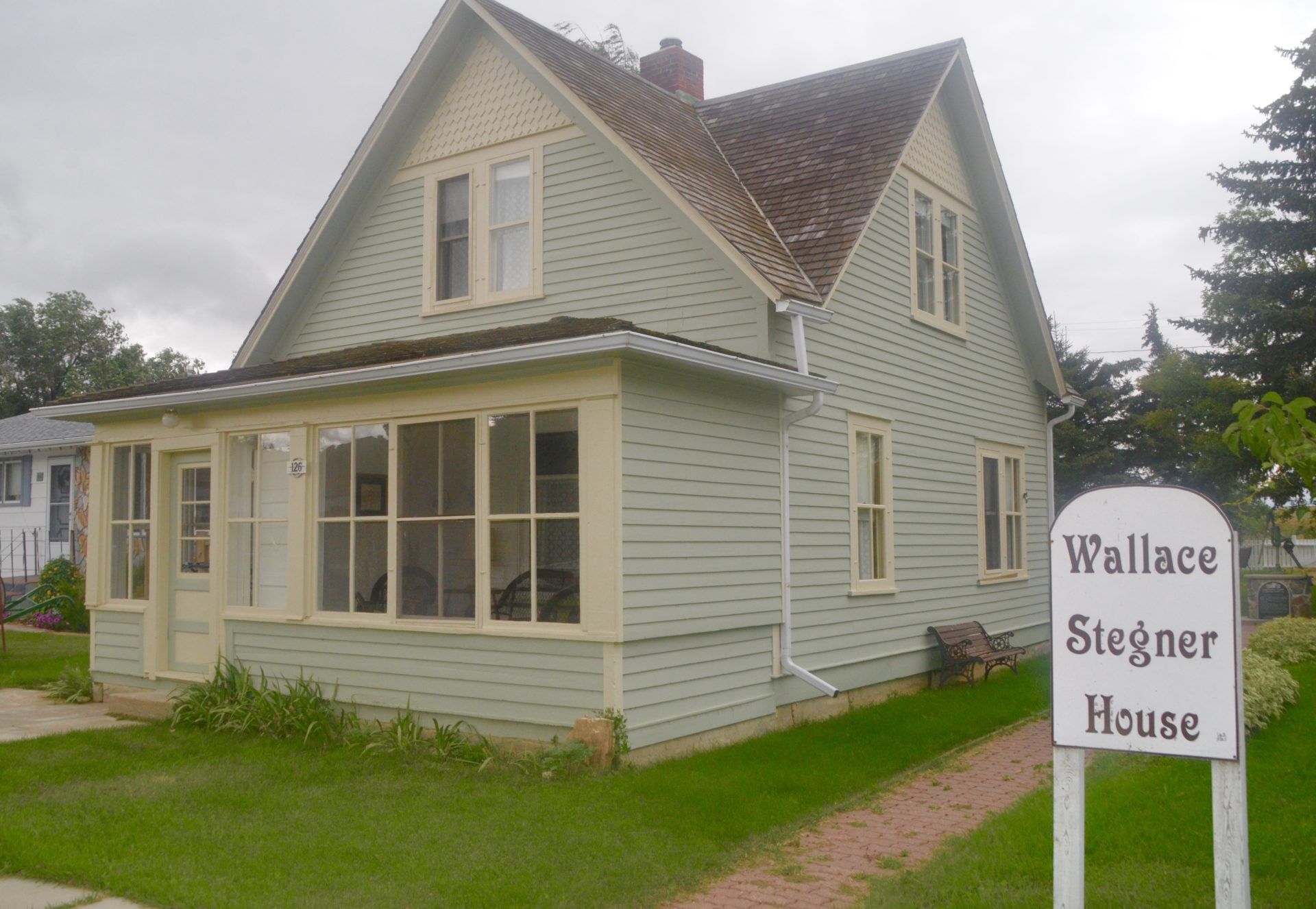
T.rex Centre, Eastend Saskatchewan
We returned to the T.rex Centre which is actually a branch of the Royal Saskatchewan Museum based in Regina. It’s housed in an intriguing semi-circular building that seems to have been literally slid into the side of a hill overlooking Eastend. It’s about as unobtrusive as a building can be.

While we were waiting for it to open I climbed up onto the natural grass roof and took this shot of Eastend Saskatchewan. You can see that it lies in a valley.

The Frenchman River, like Battle Creek in the Cypress Hills is one of the few Canadian rivers that drains into the Missouri River system. If you ask most people to identify the Continental Divide they’ll say its the line that separates rivers that drain into the Atlantic and those that drain into the Pacific, also known as the Great Divide. That is only partly correct as there are actually six divides in North America. The Laurentian Divide separates rivers that flow into Hudson Bay and those that flow into the Gulf of Mexico. This divide crosses through almost all of SW Saskatchewan and we’ll cross it twice today.
Despite the fact that this building and the proper display of its contents obviously cost big bucks, there is no admission fee, although a $5.00 donation is recommended, which we gladly made. We were the only visitors here at opening and were provided with a guided tour by a young lady by the name of Fen.
The first thing we learned was that the area around Eastend Saskatchewan has an incredible 75 million year time frame from which fossils may be gleaned. That covers a huge variety of prehistoric life all the way from the huge denizens of the primeval Bearpaw Sea through the classic Age of Dinosaurs all the way to the gigantic mammals that roamed the prairies up until 35 million years ago.
These are plesiosaur skulls from the late Cretaceous period over 135 million years ago. They are of a variety known as Terminonatator which apparently have only been found in this area of Saskatchewan. I imagine you would be quickly terminotated if caught in those jaws.
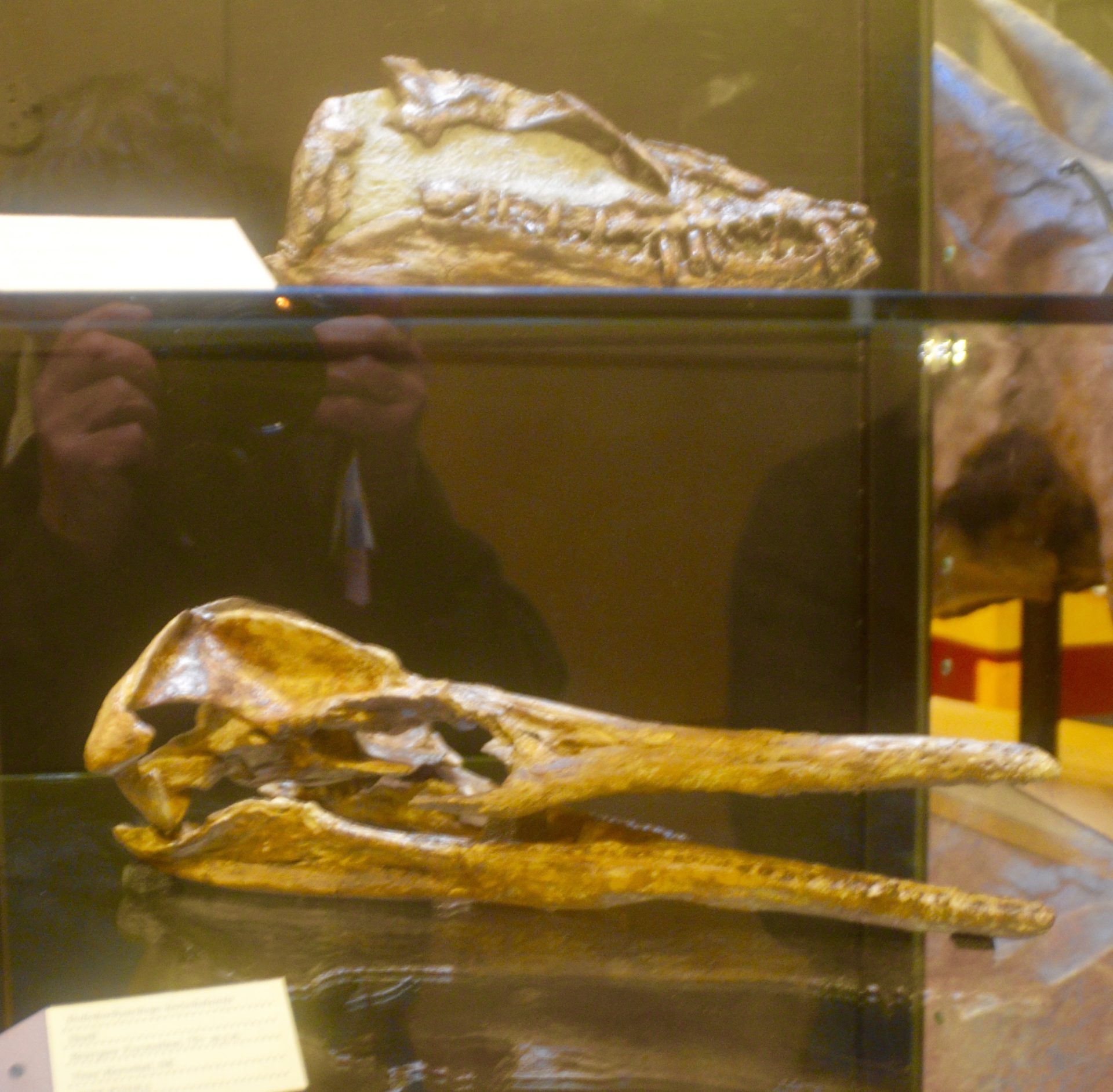
Here is what one of these plesiosaurs might have looked like in the flesh. Like modern whales and dolphins, it is believed that plesiosaurs cared for their young. You can also see why the Loch Ness monster is often described as a living plesiosaur.
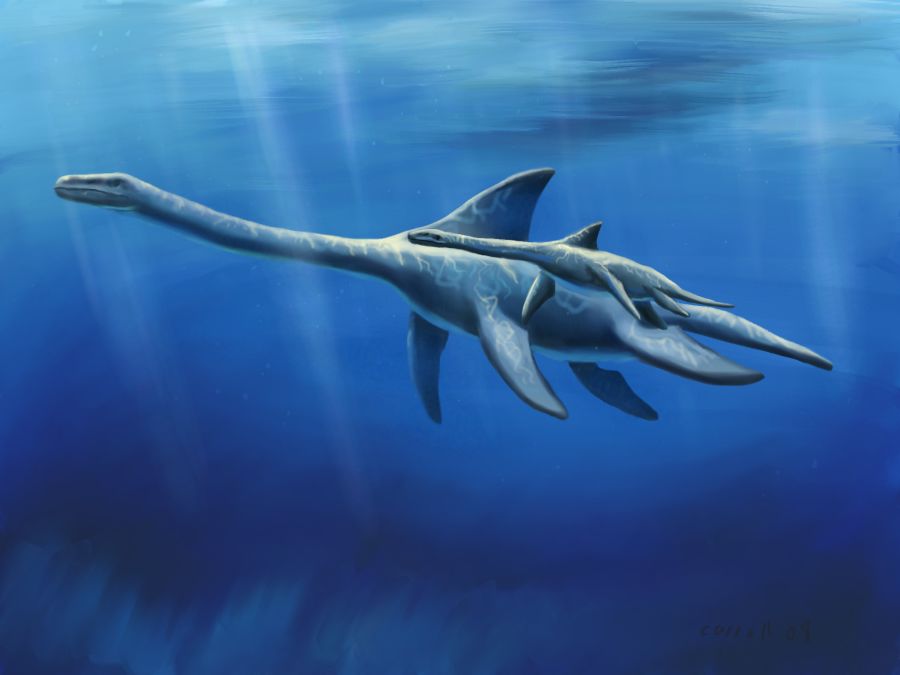
Ok, who would thought of Saskatchewan as the former home of gigantic sea monsters when the nearest ocean today is hundreds of miles away? Another Saskatchewan surprise for sure.
Everyone’s favourite horned dinosaur, triceratops was also abundant in the Eastend Saskatchewan area after the seas dried up and the plesiosaurs were long fossilized. Here is guide Fen with a massive triceratops head that was uncovered nearby.
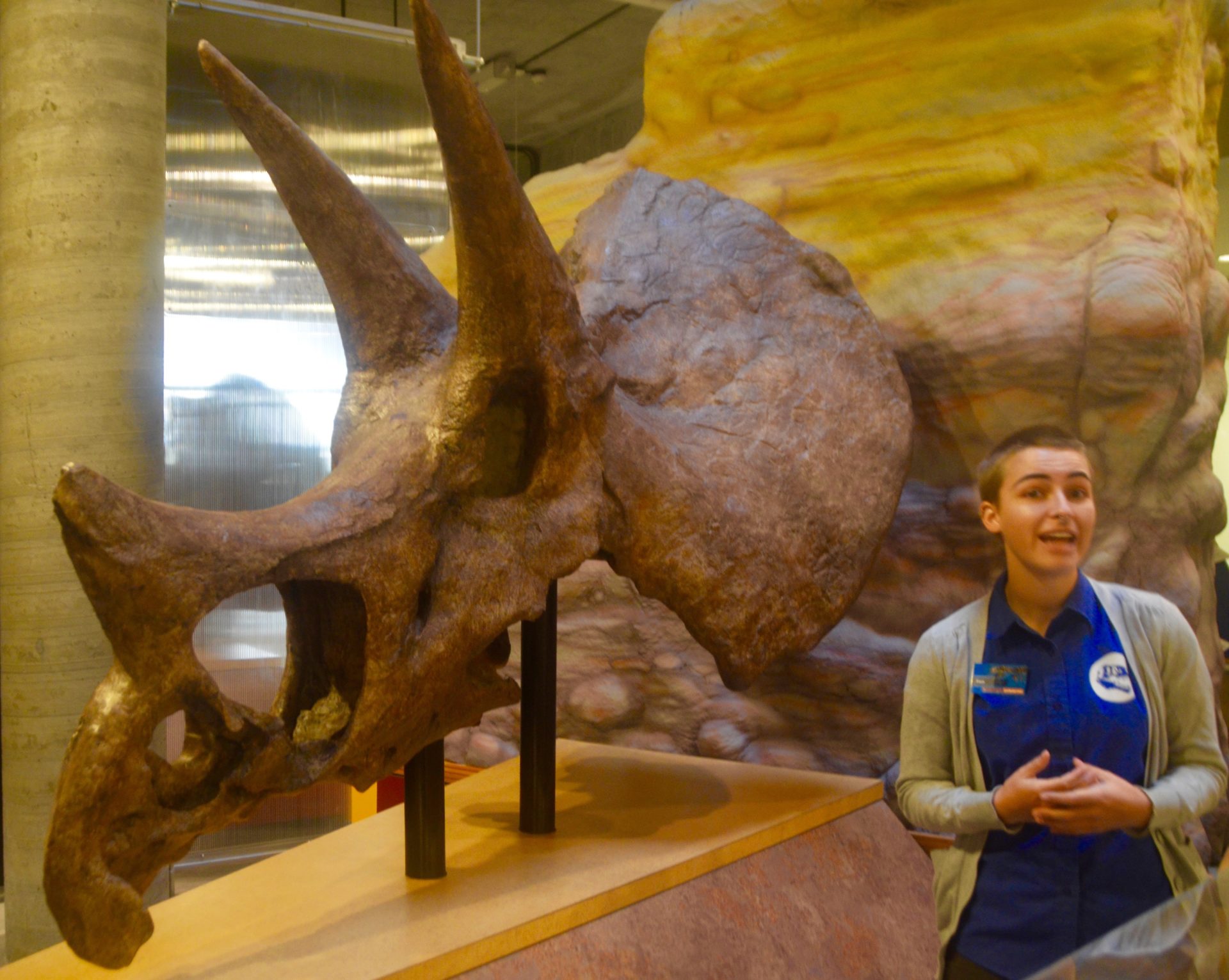
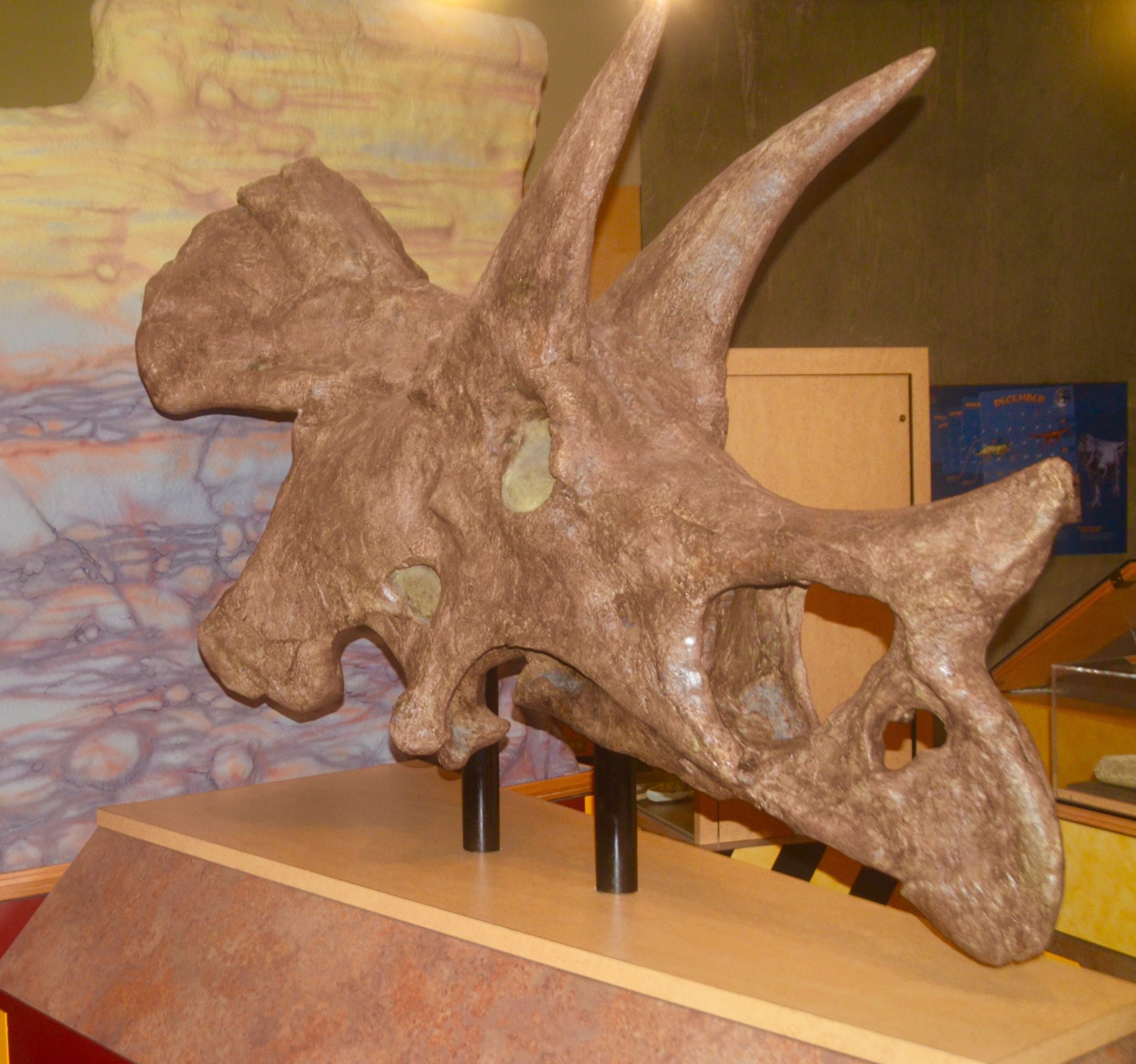
Closer inspection of the other side of the triceratops skull reveals that a huge chunk of his armour plating is missing. Fen explains that by examining the skull closely palaeontologists were able to determine that it was a wound that healed over and was not fatal. There’s only one creature that could possibly have done that. You guessed it – tyrannosaurus rex, the King of the Dinosaurs. Meet Scotty, the largest T. rex ever found and she lived just around the corner. You sure wouldn’t want to be a tourist in SW Saskatchewan during the Cretaceous Age when Scotty and family were looking for a light snack. Believe or not those jaws could rip off a 500 pound piece of flesh in one go.
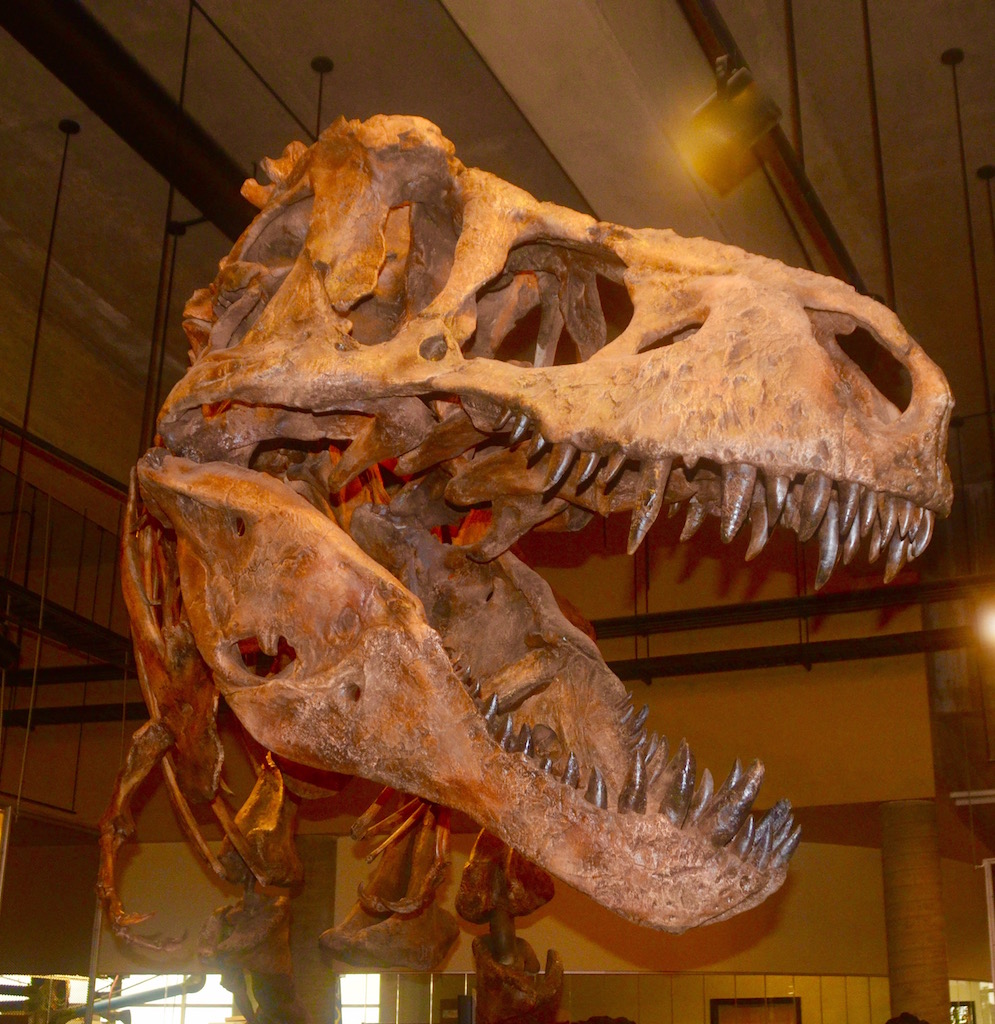
Unfortunately I couldn’t get a good shot of Scotty’s entire skeleton because of the light, but here’s one from the official website which I am sure they don’t mind sharing.
This is what modern archaeologists believe that Scotty might have looked like in life.
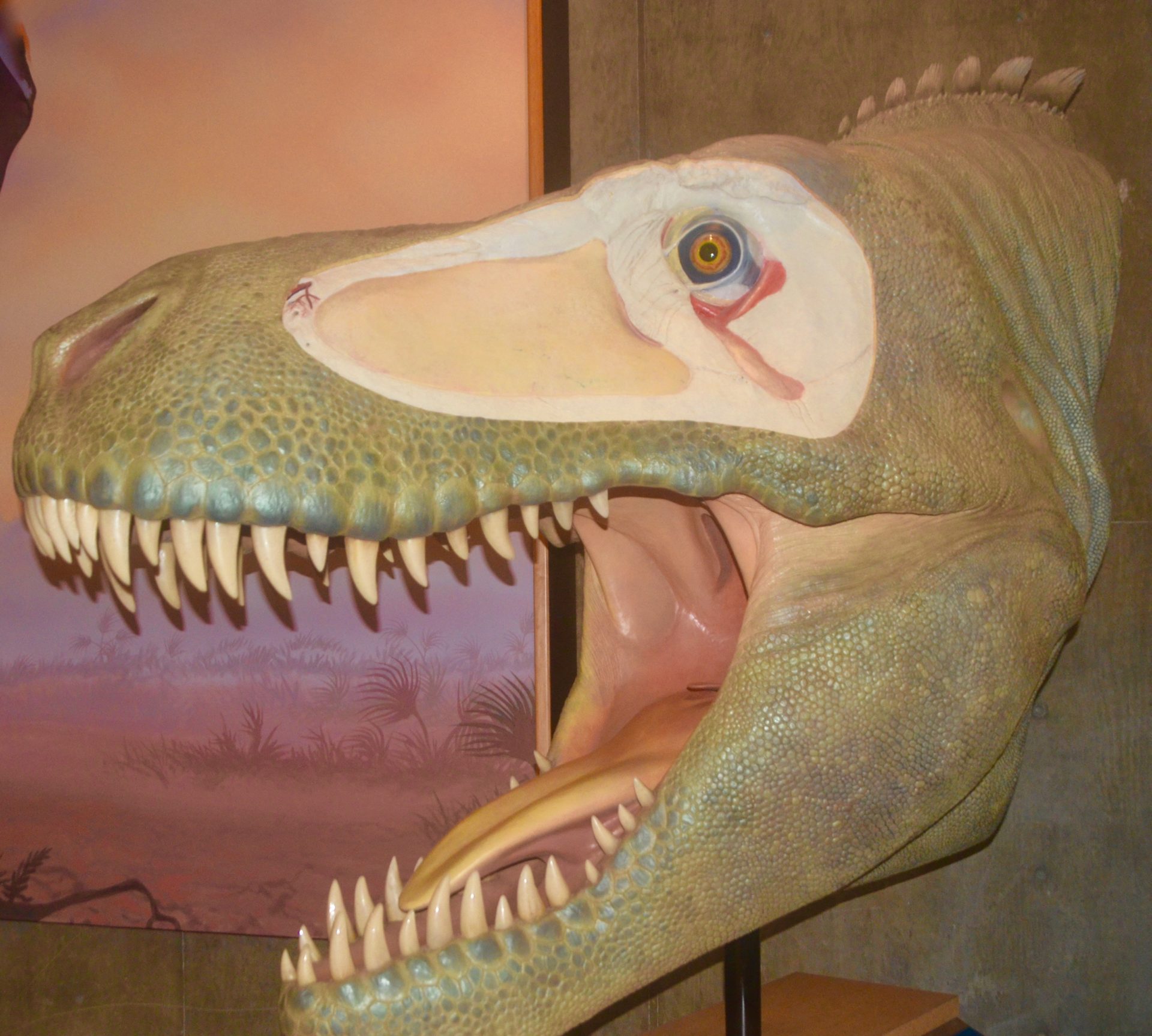
Having just come face to face with a triceratops and a T. rex, I couldn’t help but think of the many hours I whiled away as a child playing with plastic models of these two, first having T. Rex try to bite down on triceratops and then the reprisal shot to the belly by triceratops. I was hard to believe that those childhood musings actually occurred in real life around Eastend Saskatchewan.
The dinosaurs disappeared from Saskatchewan at the end of the Cretaceous, but it was not the end of the behemoths that roamed the plains. This is the skeleton of a Brontothere which lived during the Eocene period. It shared an ancestry with horses, rhinoceros and tapirs.
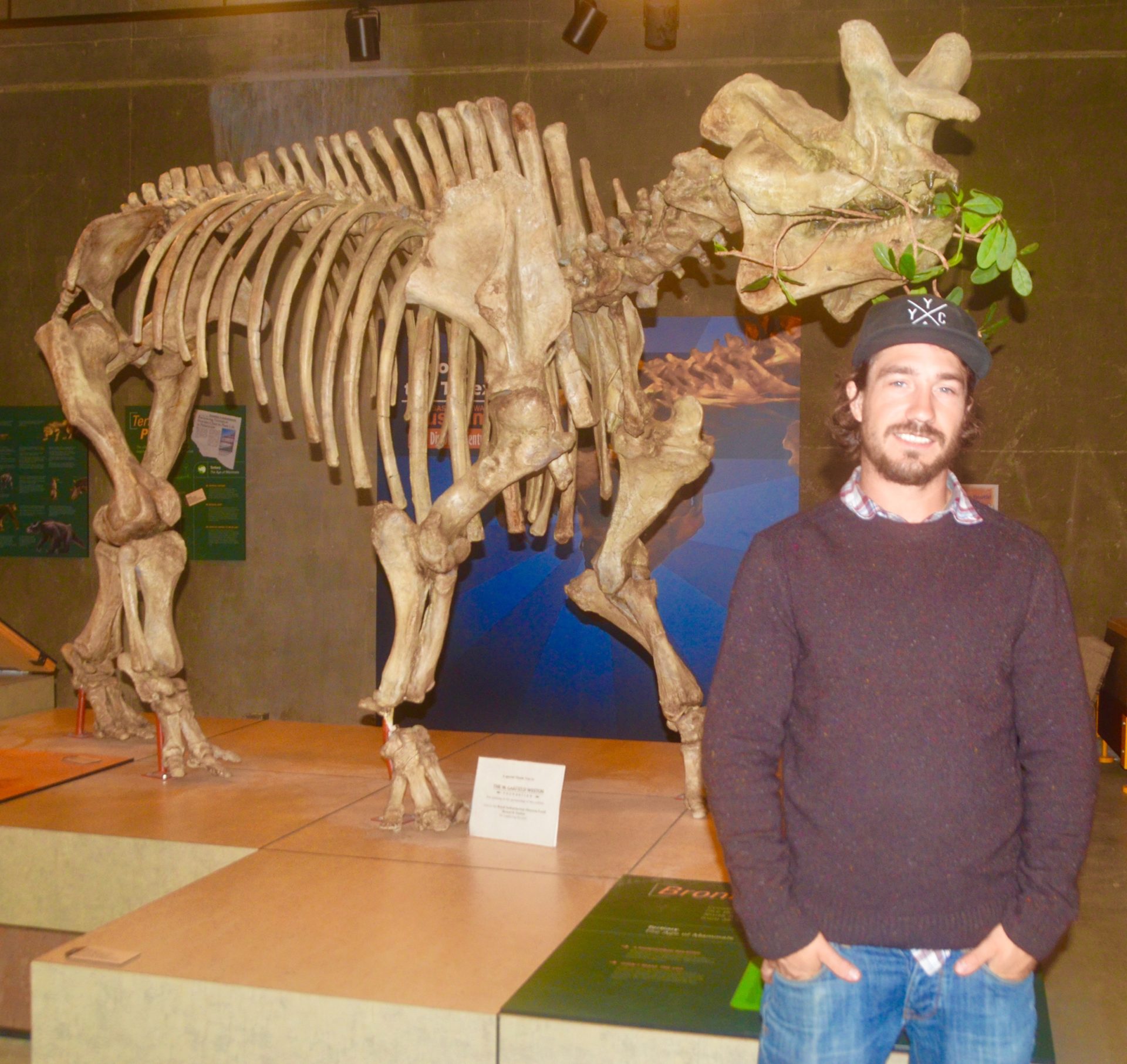
There was also something lurking in the shallow waters of the Eocene, a borealosuchus or northern crocodile.
Here’s something you won’t find anywhere else in the world. It’s a T. rex coprolite, the only one ever found. It’s fossilized poop and from examining it scientists were able to determine that the flesh that was eaten came from a live animal and not a carcass, thus dispelling the theory that T. rex was really just a lowly scavenger.
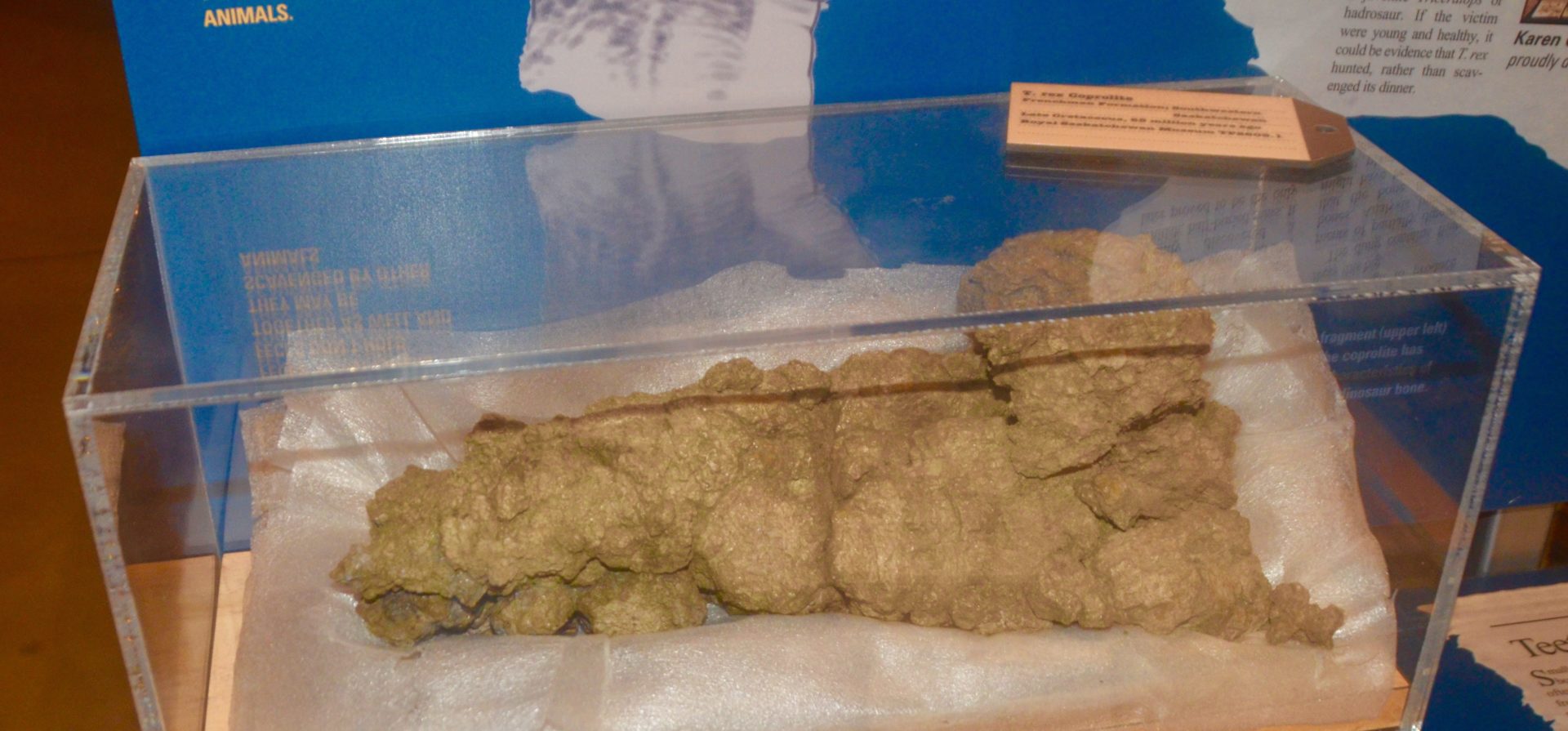
The exhibits are separated from the working lab at the T. rex Centre where the actual fossils, including Scotty’s are preserved and analyzed. Every year the centre conducts digs in the Eastend Saskatchewan area and volunteers are welcomed. I know if I was still a young man I could certainly see myself being more than happy to join an expedition that might unearth another prize like Scotty.
Eastend Historical Museum
Our next stop was unplanned. Dale noticed that there was a slow leak in one of the Altima’s tires and went into a general store to buy a tire patch kit. As it turns out there was no parking for the RV on the main street so I pulled off onto a side street and parked beside some old farming relics. This ended up being right beside the Eastend Historical Museum.
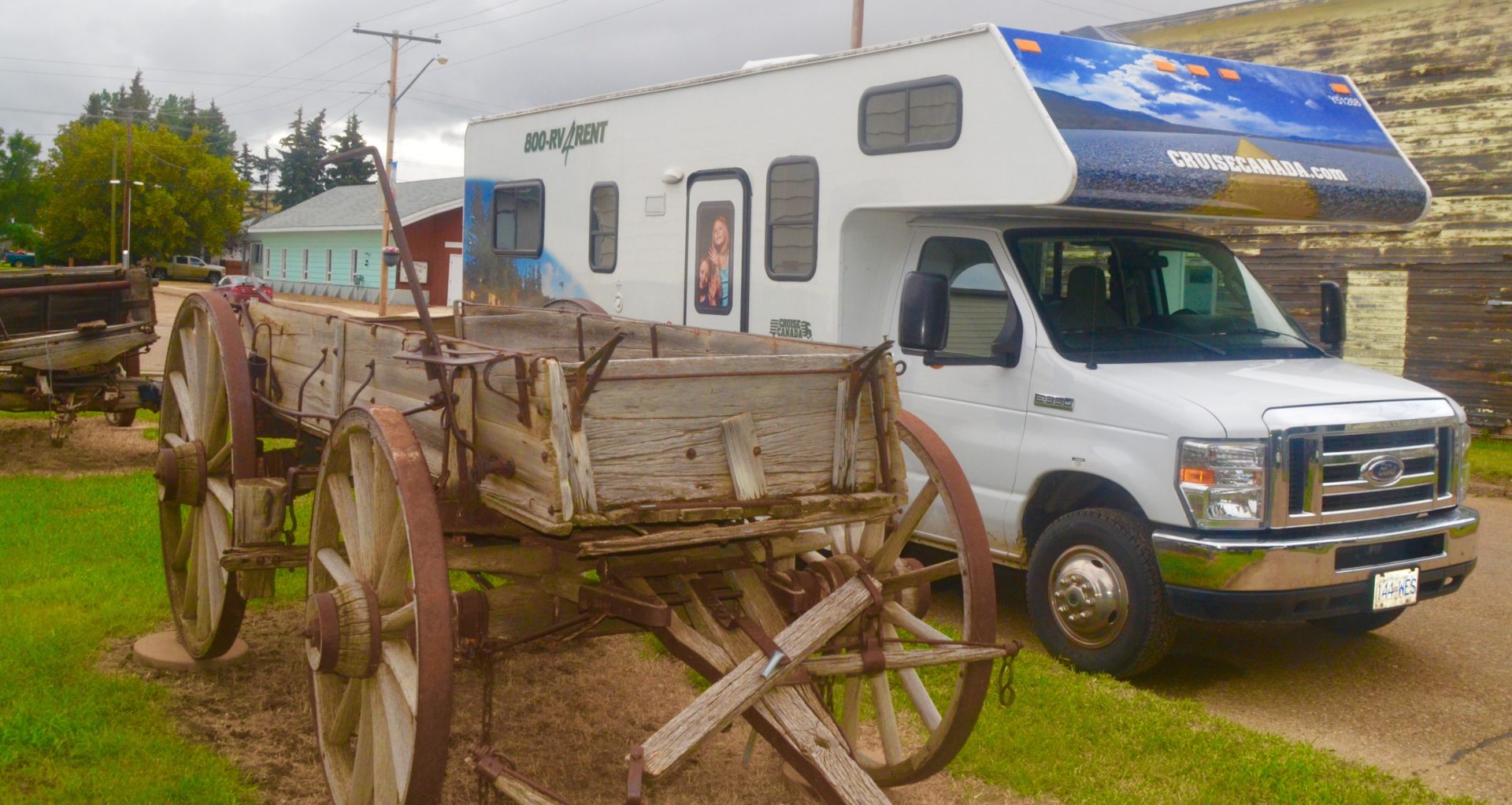
Just as I’ve always had a passion for dinosaurs, so with museums. When we moved to The Pas many moons ago, the first place I wanted to visit was Sam Waller’s Little Northern Museum. It was Sam’s personal collection of anything he thought was interesting. I visited it dozens of times over the years I lived in The Pas even though the exhibits never changed. I’ll never forget looking through a microscope to see a collection of fleas dressed in tiny clothes – really! The stuffed animals were my favourites, including the proverbial two-headed calf. I’ve kept this love of small town museums all my life and seldom can resist visiting. I know a lot of them are crappy and boring, but lot’s aren’t. I want to find out what category this one falls into.
There is a $5.00 admission fee which seems steep for a small town museum, but it’s to help finance a new addition to the museum so I don’t begrudge it at all. Most of these type of museums are struggling so it’s nice to see one that is expanding. The first thing I notice is this collection of military uniforms. I immediately recognize the one on the right as it is identical to the one my father wore in the RCAF during WWII, The one in the middle seems very like the one both my grandfathers wore in WWI.
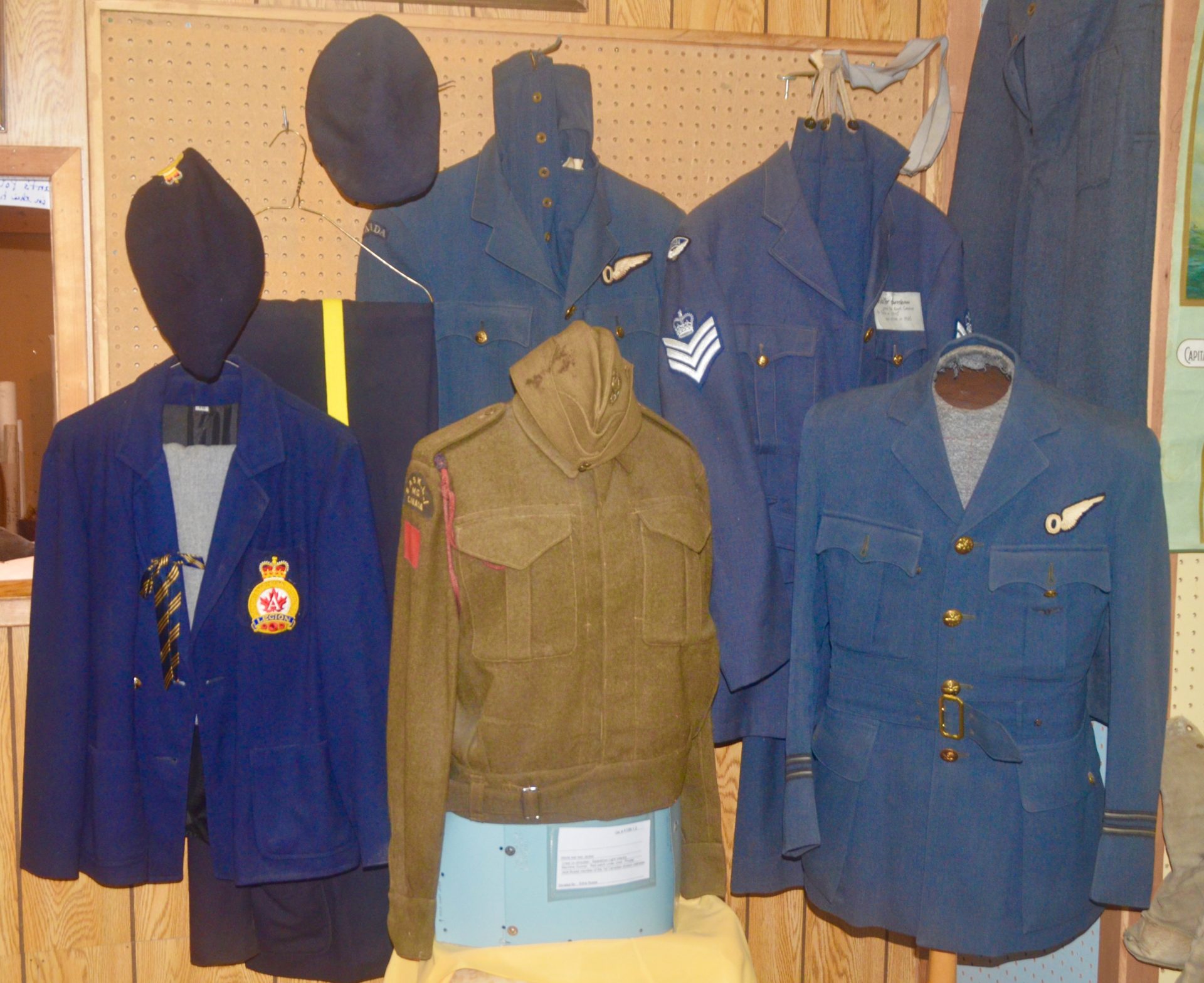
The second thing I see sends chills down my spine.
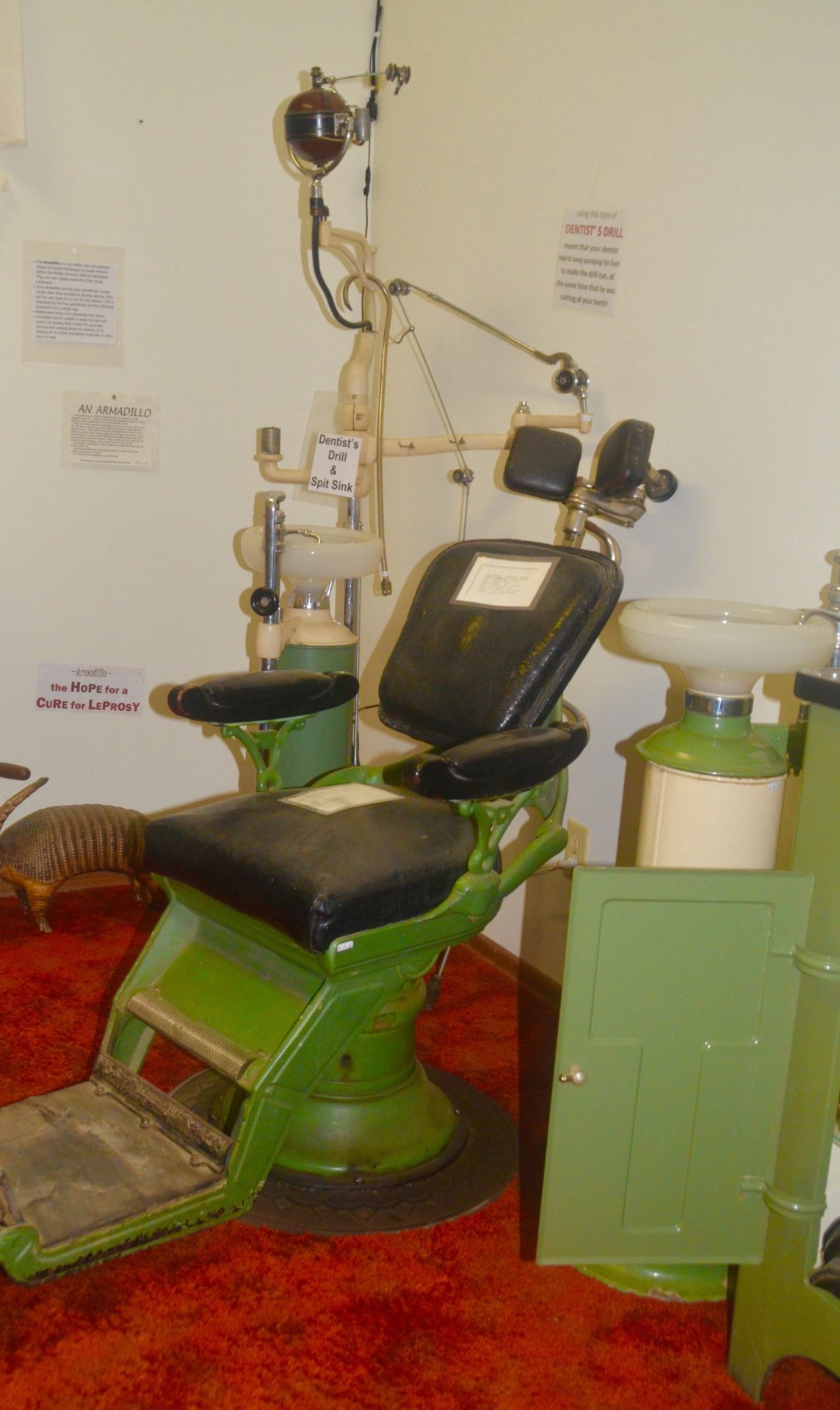
It’s an old dentist’s office and reminds me exactly of the first one I can remember when the drill was operated manually by a foot peddle and the drill would actually create smoke from your teeth as the dentist worked on causing the maximum amount of pain and discomfort possible. Looking at this actually brought that smell back to mind and I almost threw up. Hope there’s better stuff ahead and there is.
The museum is actually made up of a collection of early pioneer buildings and is far larger than you would think from the exterior. Here is an original homesteader’s shack from 1916.
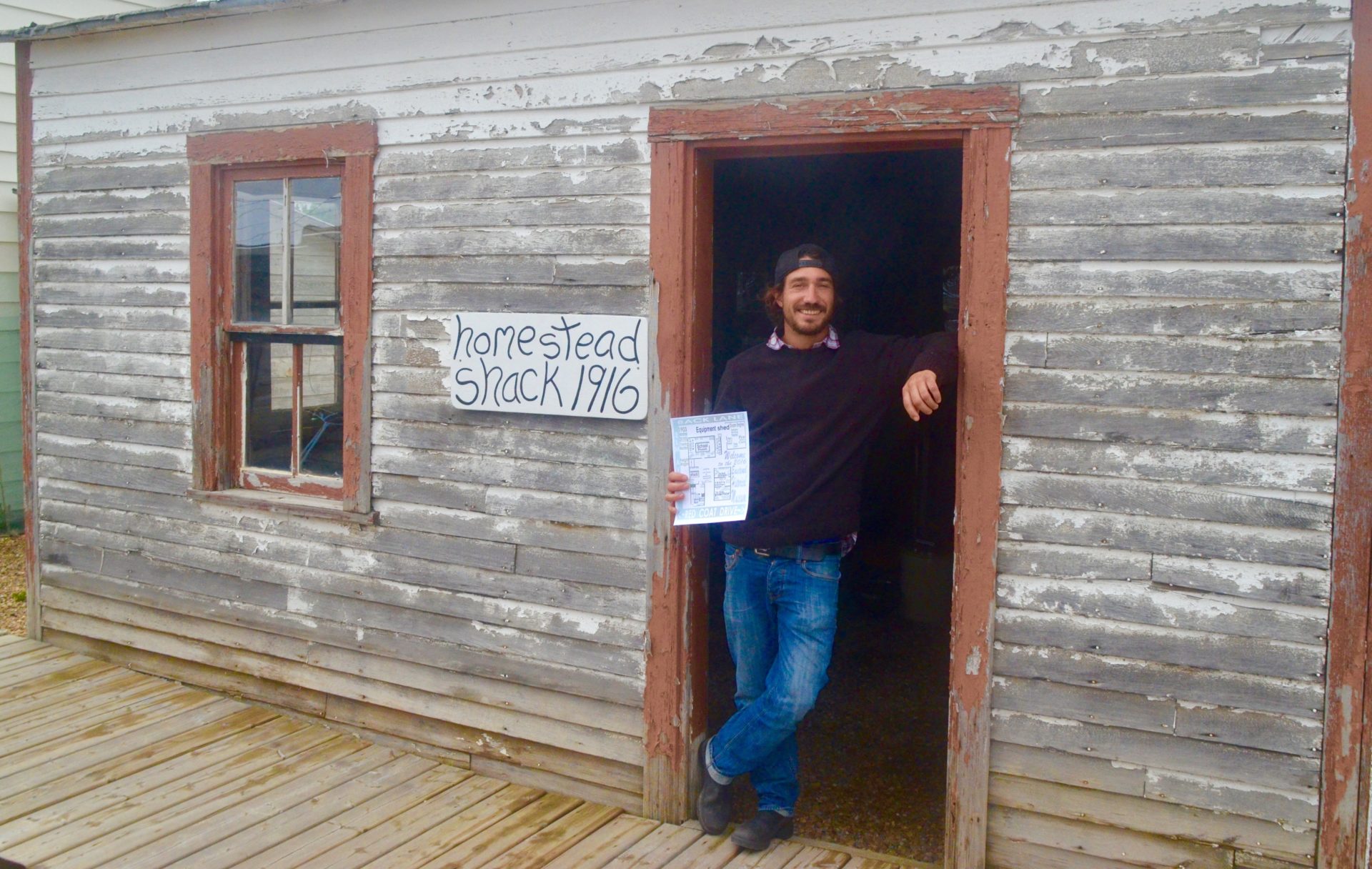
The interior of the place is pretty bleak with a dirt floor and very uncomfortable looking bed. I can almost hear the winter prairie wind blasting through the cracks between the boards. You had to be one tough family to start your life in Canada living in a place like this. Compare it to the relatively luxurious accommodations the NorthWest Mounted Police had at Fort Walsh forty years earlier.
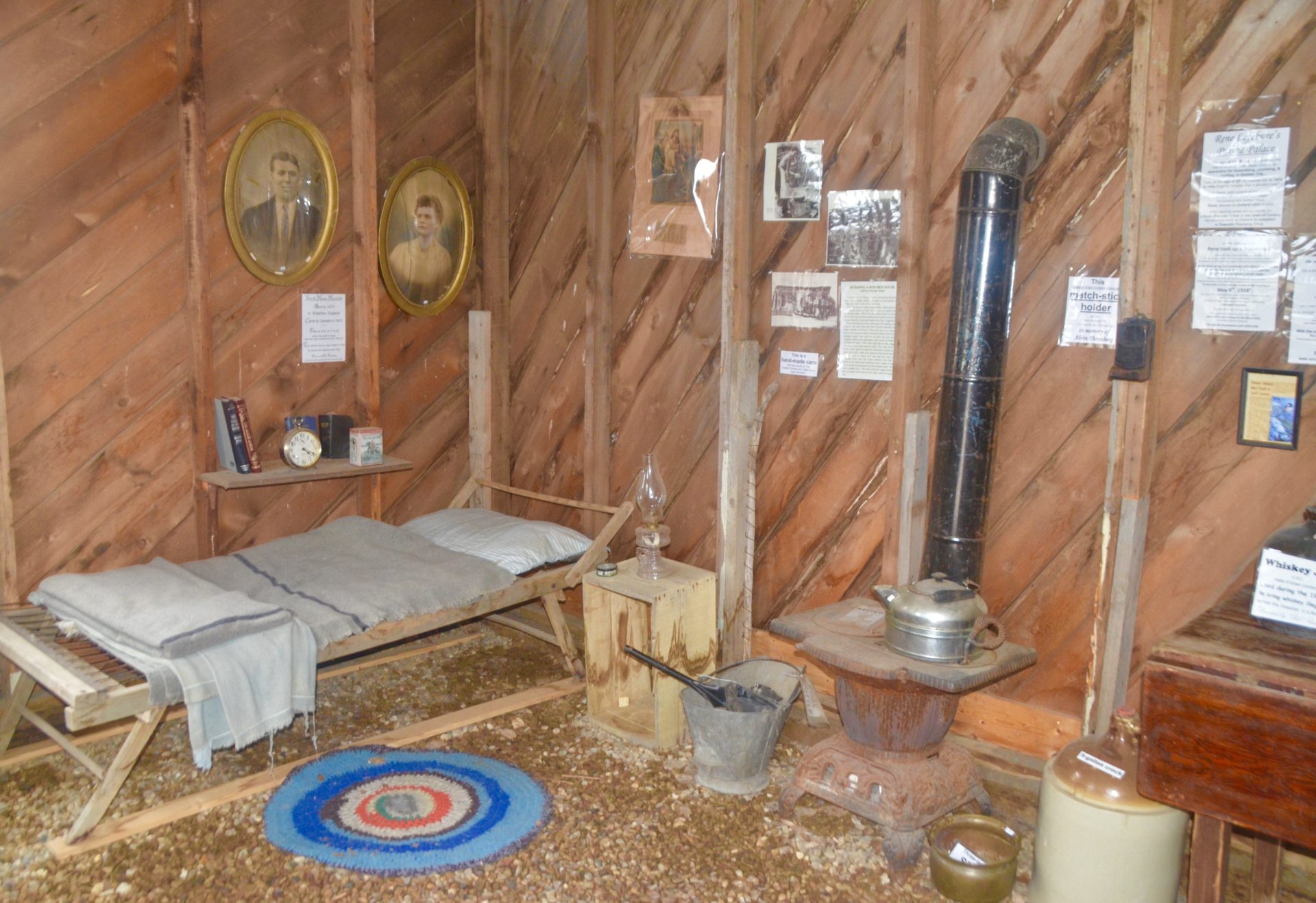
One of the most common displays in country museums is a recreation of the one room schoolhouse. I believe the one in the Eastend Historical Museum is as good as any I’ve seen, except for maybe the teacher.
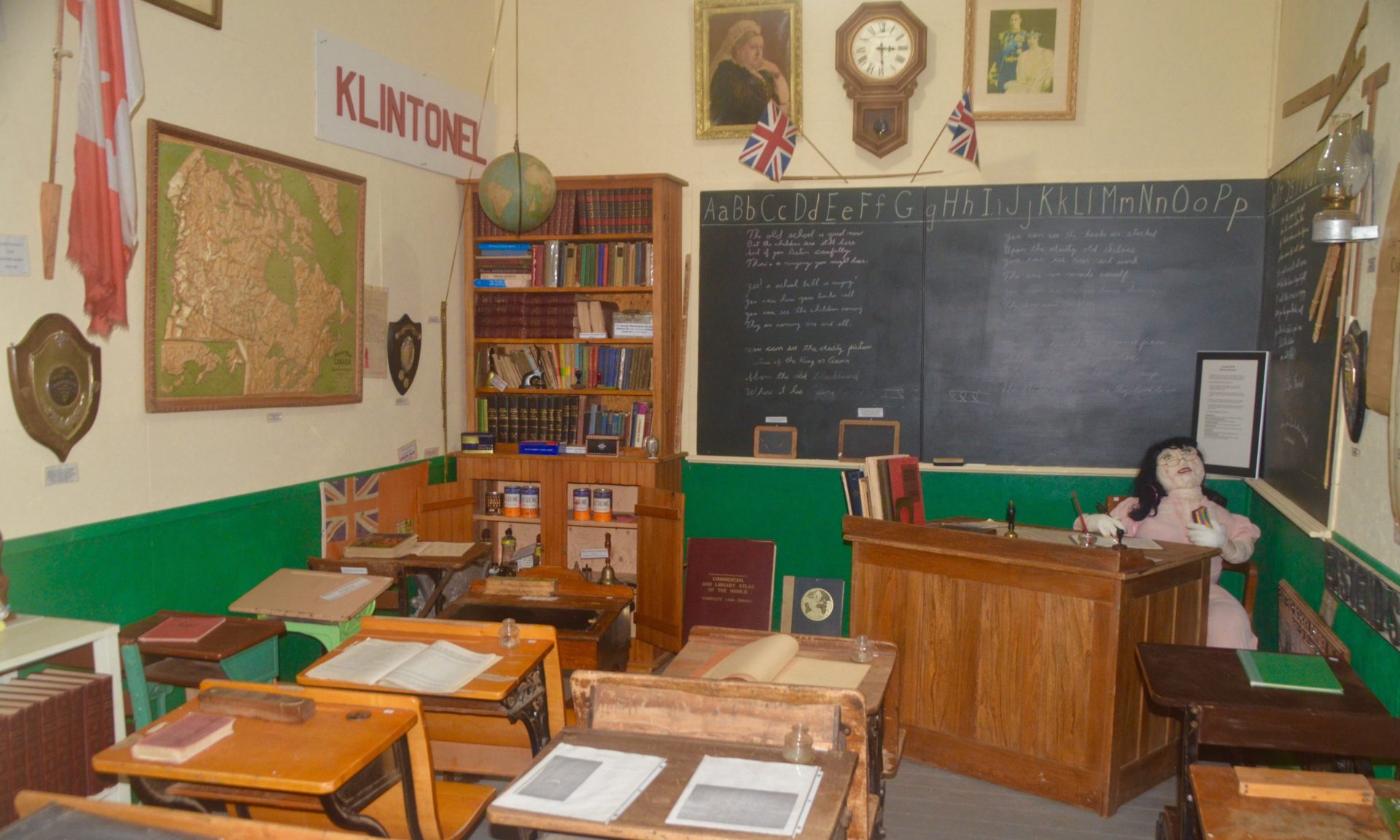
I didn’t go to a one room schoolhouse (Alison did, for six years), but I did sit in desks exactly like these and I’m sure there’s probably some still around somewhere with my initials carved into them. Maybe I’ll do it here too! Just kidding, I’m really just an angel of a pupil.
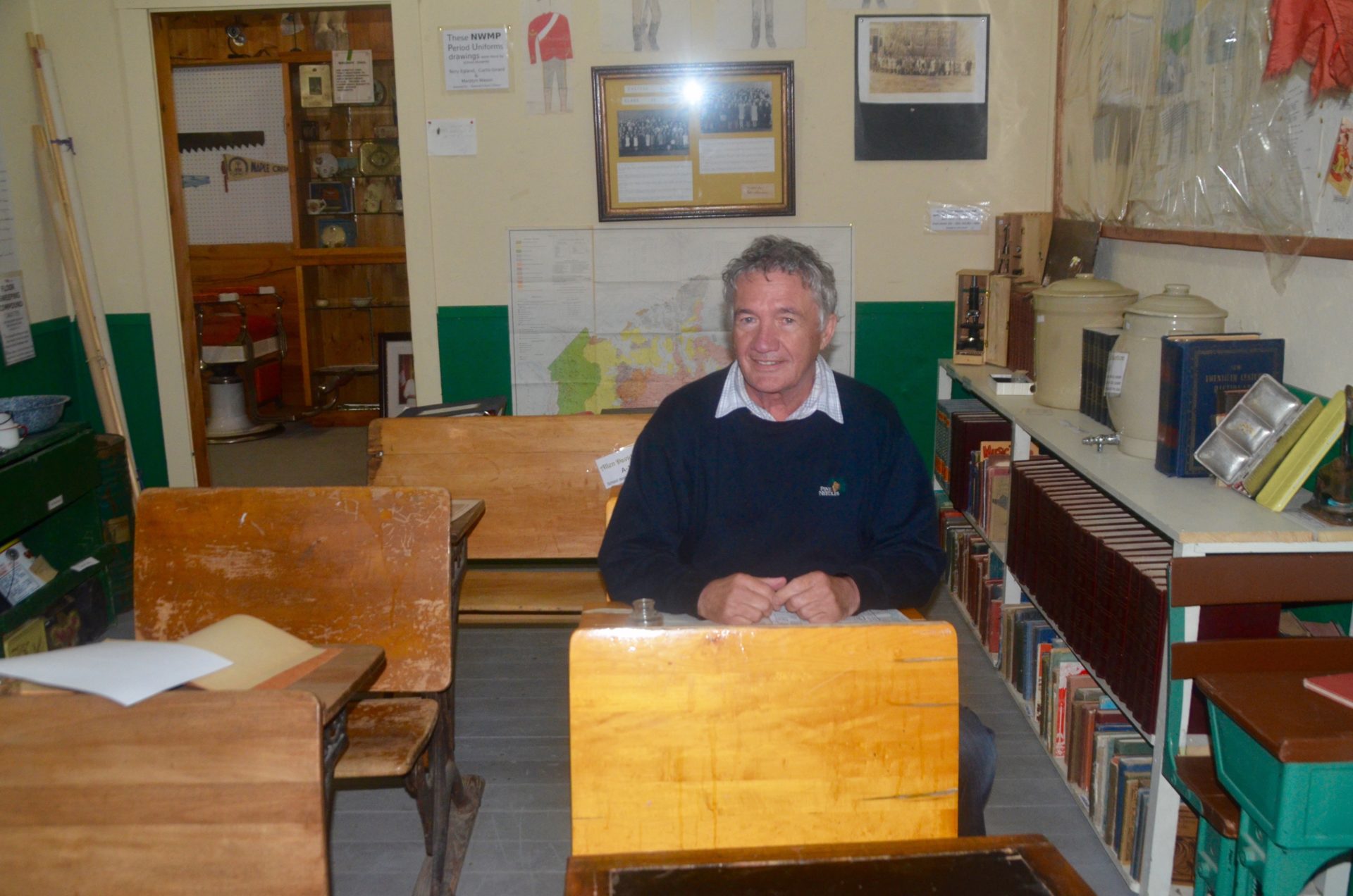
Here’s something that also brought back memories, much fonder ones then the dentist’s office.
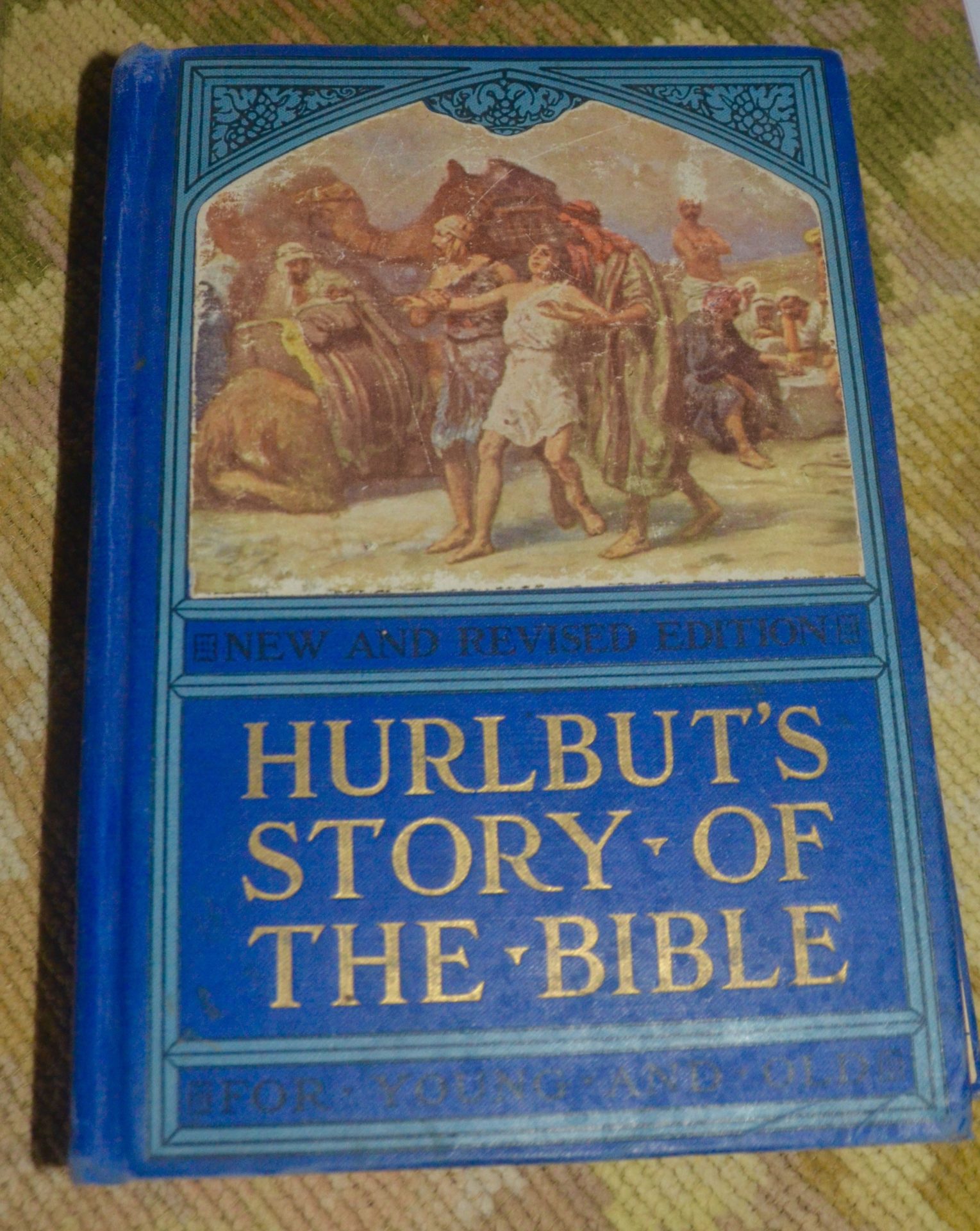
Hurlburt’s Story of the Bible was one of my go to books when I was young. I am sure I read it cover to cover many times and the amazing stories have stuck with me over the years. Although it did not succeed in making me a believer, I still cherish my copy and have read it to the children when they were younger and now the grandchildren. If you ever see a copy in a used book store snap it up or do what most people do these days, buy it on Amazon.
Every one of these little town museums has something completely quirky and unique and I don’t mean a two-headed calf. In this case it’s a slab of eighty year old bacon. Apparently it got hung up and forgotten about for decades. Why the flies never got it or a hungry dog, I don’t know, but it’s one of those things that’s so stupidly banal that it’s actually interesting.
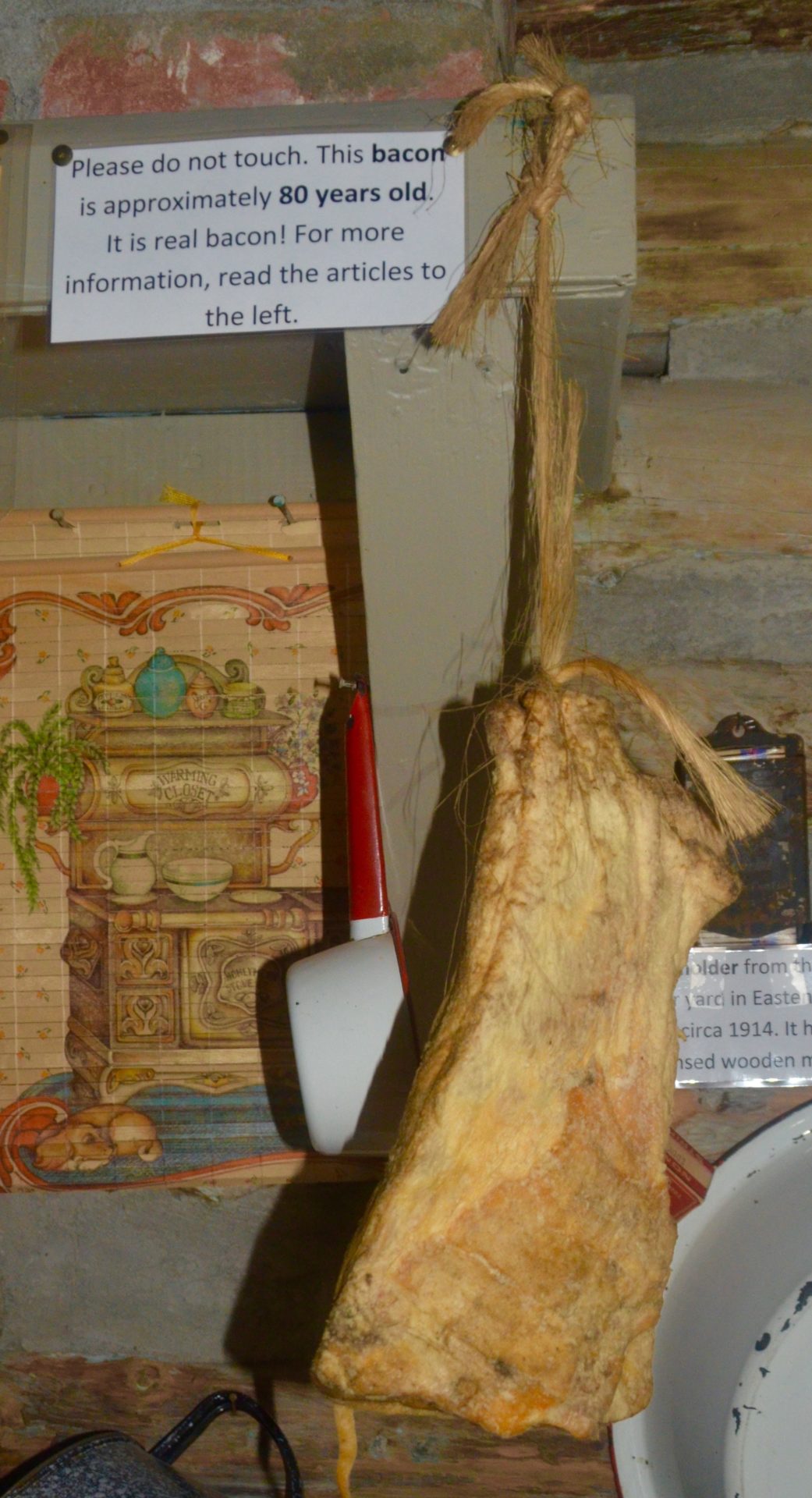
As a mechanic Dale is always most interested in things that have engines and we found a few in the back part of the museum. There was no sign telling him not to get in so he decided to try his hand driving this 1919 Federal truck.
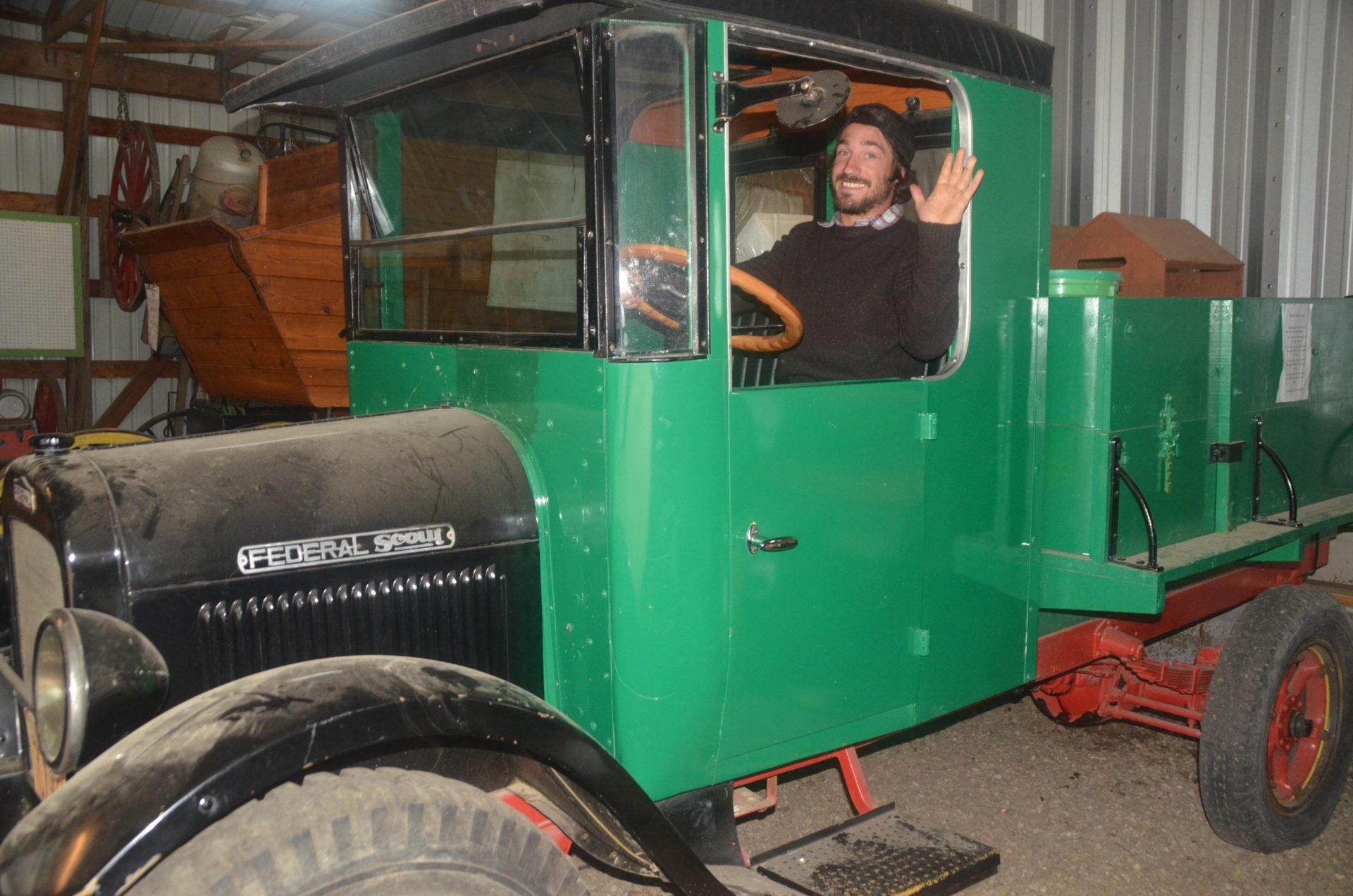
An even better find was this massive 1903 Case Steam Tractor.
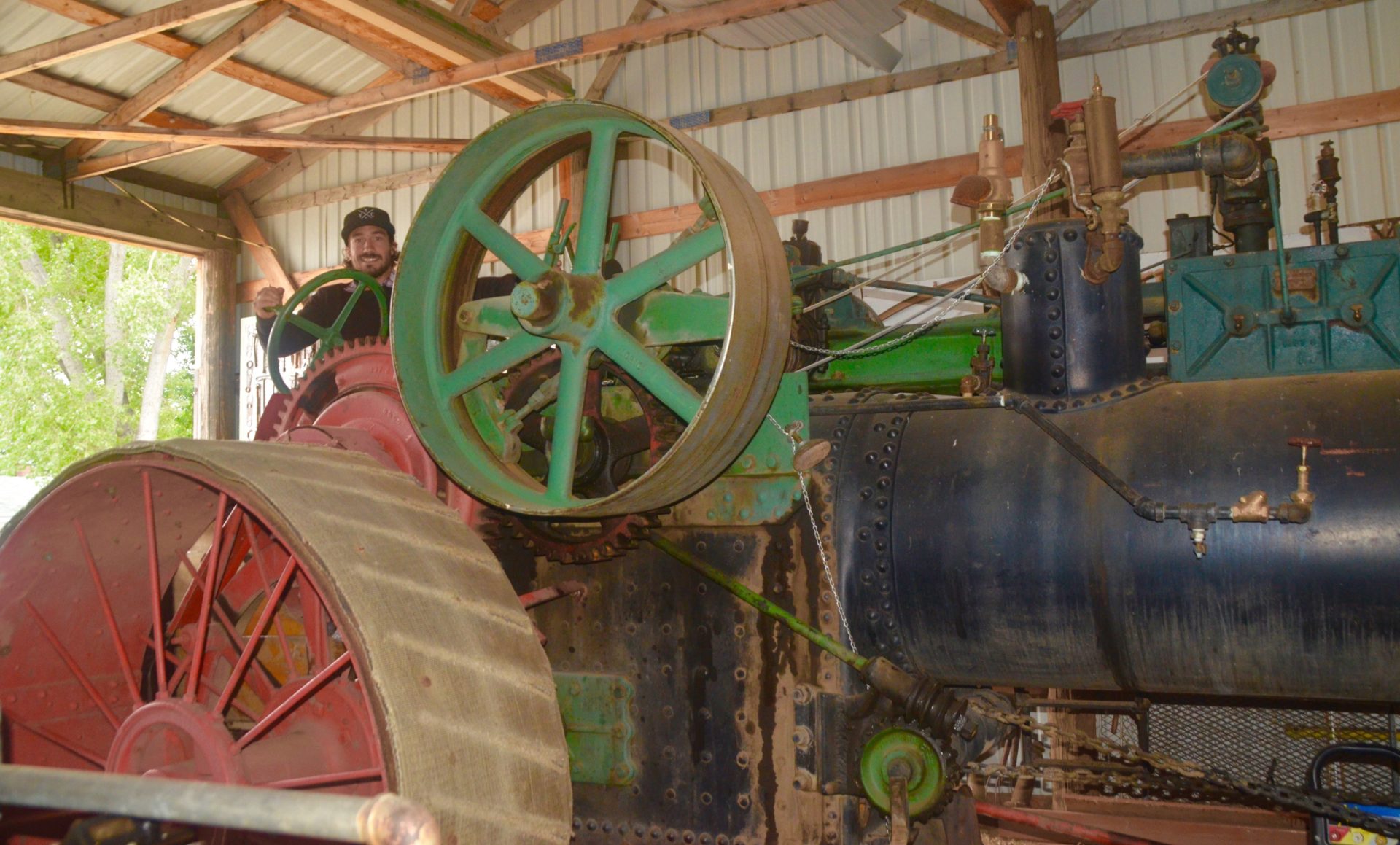
Can you imagine driving this thing to till your fields or thresh your wheat?
Well I’ve written over 2,300 hundred words just on Eastend Saskatchewan. I guess it must be an interesting place, eh? Why not check it our for yourself? Next Dale and I will continue our Saskatchewan odyssey by looking for the quintessential prairie structure – the wooden grain elevator. Please join us on our quest.
Here is a link to a photo gallery of our entire Saskatchewan trip.

